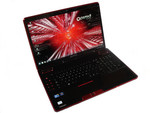Toshiba Qosmio X500-10V
Specifications

Price comparison
Average of 6 scores (from 6 reviews)
Reviews for the Toshiba Qosmio X500-10V
Big Gamer with Multimedia Ambitions. Toshiba presents a 18.4 inch notebook that is predestined for gaming thanks to the heavy duty Core i7 processor and the allegedly efficient GeForce GTS 250M with its Qosmio X500-10V. The desktop replacement notebook is equally qualified as an entertainment system with an integrated BluRay drive, a FullHD resolution display and a sound system. Read in our review if these pretensions can be completely satisfied.
Source: Notebookcheck
 DE→EN Archive.org version
DE→EN Archive.org versionSingle Review, online available, Long, Date: 09/23/2010
Rating: Total score: 84% performance: 93% display: 78% mobility: 57% workmanship: 86% ergonomy: 81% emissions: 76%
Source: e-media - 4/10

Single Review, , Very Short, Date: 04/01/2010
Rating: Total score: 80% price: 80% performance: 100% mobility: 60%
Source: e-media - 4/10

Single Review, , Very Short, Date: 03/01/2010
Rating: Total score: 80%
Source: c't - 4/10

Comparison, , Very Long, Date: 02/01/2010
Rating: performance: 85% features: 80% display: 40% mobility: 70% ergonomy: 80% emissions: 80%
Source: Notebookcheck
 DE→EN Archive.org version
DE→EN Archive.org versionSingle Review, online available, Long, Date: 12/29/2009
Rating: Total score: 85% performance: 92% display: 80% mobility: 59% workmanship: 88% ergonomy: 83% emissions: 80%
Source: Techno Zoom
 IT→EN Archive.org version
IT→EN Archive.org versionSingle Review, online available, Very Short, Date: 01/10/2010
Rating: Total score: 90% price: 80% performance: 90% mobility: 70% workmanship: 80%
Comment
NVIDIA GeForce GTS 250M: The GPU has 96 shader cores but only a 128 bit memory bus that supports GDDR5 memory. With DDR3 memory, the GTS 250M performs clearly worse. Because of the 40nm process (and a selection process) the 250M offers a relatively low power consumption (the 260M needs 10W more).
Non demanding games should be playable with these graphics cards.
» Further information can be found in our Comparison of Mobile Graphics Cards and the corresponding Benchmark List.
Intel Core i7: The Intel Core i7 for laptops is based on the LG1156 Core i5/i7 CPU for desktops. The base clock speed of the CPUs is relatively low, but because of a huge Turbo mode, the cores can dynamically overclock to up to 3.2 GHz (920XM). Therefore, the CPU can be as fast as high clocked dual-core CPUs (using single threaded applications) but still offer the advantage of 4 cores. Because of the large TDP of 45 W / 55 W, the CPU is only intended for large laptops.
720QM: The Core i7-720QM is the slowes Core i7 Quad Core in 2009 and clocks between 1.6 and 2.8 GHz (due to the Turbo Mode). Therefore, it combines the advantages of a slow quad core CPU with a fast single core one. Compared to the faster Core i7 mobile CPUs, the 720QM only features 6MB L3 Cache.» Further information can be found in our Comparison of Mobile Processsors.



